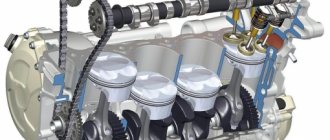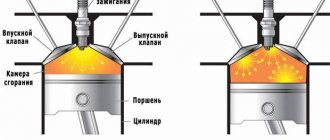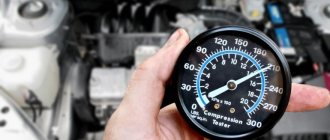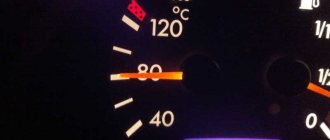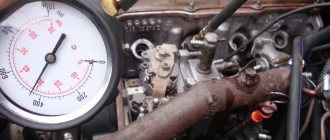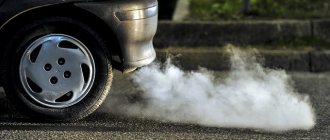An internal combustion engine (gasoline, diesel) is a complex device consisting of many mechanisms and systems.
Their interaction with each other makes it possible to convert the energy generated during the combustion of the fuel-air mixture into the rotational movement of the crank mechanism with further transmission of rotation to the transmission.
The main work on energy conversion occurs inside the cylinder-piston group, namely in the cylinders.
Energy conversion depends on many factors, including engine compression ratio and compression. These criteria are especially important in diesel power plants, since ignition of the combustible mixture in the cylinders of such engines occurs as a result of its heating due to compression.
The concept of compression ratio
Often these concepts are confused with each other or combined into one term. In reality, these are two different terms, and they are characterized differently.
First, let's look at everything about the compression ratio of a diesel engine.
The ratio of the volume of the engine cylinder when the piston is at bottom dead center (BDC) to the volume of the combustion chamber at the moment when the piston reaches top dead center is the compression ratio of the engine.
This ratio indicates the pressure difference that occurs in the engine cylinder at the moment fuel enters the cylinder.
In the technical documentation that comes with the diesel power plant, the compression ratio is indicated as a mathematical ratio, for example, 18:1.
For a diesel unit, the most optimal compression ratio varies from 18:1 to 22:1. It is at such indicators that this engine achieves maximum efficiency indicators.
Normal pressure
To correctly determine the norm of oil pressure indicators, you need to understand that measurements must be carried out in two ways:
- at idle - around 2 bar or 0.2 MPa;
- at high speeds - from 4 to 7 bar.
Please note that the operating manuals must indicate the parameters corresponding to the specific model. Having identified a non-compliance with these standards, it is necessary to take emergency measures to eliminate this dangerous defect.
How it all works
In a diesel engine, during the compression stroke, when the piston moves to TDC, the volume in the cylinder quickly decreases. At this moment, there is only air in the combustion chamber, it is compressed, this process is called the compression stroke.
As the piston approaches TDC, the air is compressed to the compression ratio specified in the documentation, and fuel is supplied to the combustion chamber under pressure.
The mixture of fuel and air, due to the effect of high pressure on it, ignites, significantly increasing the pressure inside the chamber, the piston at this moment passes TDC.
The high pressure resulting from the combustion of the air-fuel mixture begins to put pressure on the bottom of the piston, forcing it to move to BDC.
Through the connecting rod, the translational movement of the piston is converted into rotational movement of the knees. shaft
In this case, the pressure resulting from the ignition of the mixture forces the piston to move to BDC, called the power stroke. The power stroke is one of the strokes of the cylinder-piston group.
During the compression stroke, the compression ratio is what matters. The higher it is, the easier it is for the combustible mixture to ignite and the more completely it will burn, providing greater pressure.
With a good compression ratio, a diesel engine will provide greater power output with less fuel burned.
More on the topic - Different compression in the cylinders, what to do, consequences.
However, it is not for nothing that diesel power plants have a compression ratio range beyond which it is not recommended.
A compression ratio of less than 18:1 leads to a decrease in the power indicator of the installation, while fuel consumption increases.
But an excessive compression ratio of the engine also has a negative effect on the engine, especially a diesel one. Due to the increased loads experienced by the cylinder-piston group, their service life is reduced very quickly.
Increasing the compression ratio above normal can lead to piston burnout and connecting rod bending.
In some cases, an increase in this indicator leads to an explosion of the power plant without the possibility of subsequent recovery.
IMPORTANT TO KNOW: The compression ratio of hydrogen engines is much higher.
Possibility of measuring the compression ratio
It is almost impossible to check the compression ratio of a diesel unit in a garage. Because you need to take some measurements, which are very difficult to do.
One of these measurements is to determine the volume in the cylinder when the piston is at TDC.
Next, you need to know some parameters of the power plant, some of which can be found out from those. documentation, but some are quite difficult to find out.
To calculate the compression ratio, you will need to know the volume of the combustion chamber, since there is a gasket between the cylinder block, you need to know its thickness and the diameter of the piston hole in it, the piston stroke and the cylinder diameter.
Having all this data, as well as measuring the volume in the cylinder, you can mathematically calculate the compression ratio.
Car Forums POKATILI.RU
| Current time: Tue Sep 07, 2022 17:37 |
Time zone: UTC + 4 hours [Summer Time]
Diesel engine compression ratio
Well, you just asked for it, I hope we’ll give you a special title on this occasion
